Soil Moisture Regulation under Mulched Drip Irrigation Influences the Soil Salt Distribution and Growth of Cotton in Southern Xinjiang, China
Abstract
:1. Introduction
2. Results
2.1. Effects of Soil Moisture Lower Limit Regulation on Soil Water Content during Cotton Growth Period
2.2. Response of Soil Salt Distribution to Soil Moisture Lower Limit Regulation at Growth Stages
2.3. Impacts of Soil Moisture Lower Limit Regulation on Soil Salt Accumulation during the Cotton Growth Period
2.4. Influence of Soil Moisture Lower Limit Regulation on Cotton Growth, Yield, Water, and Nitrogen Use Efficiency and Correlation Analysis between the Indexes
3. Discussion
3.1. Spatial and Temporal Distribution of Soil Moisture and Soil Salinity under Mulched Drip Irrigation
3.2. Soil Salt Accumulation with Soil Moisture Lower Limit Regulation
3.3. Crop Growth, Yield, Water, and Nitrogen Use Efficiency with Soil Moisture Lower Limit Regulation
4. Materials and Methods
4.1. Experimental Site
4.2. Experimental Design and Arrangement
4.3. Measurements and Methods
4.3.1. Irrigation Schedule
4.3.2. Plant Height, Above-ground Dry Matter, Nitrogen Uptake, and Root–Shoot Ratio
4.3.3. Leaf Area Index
4.3.4. Cotton Yield
4.3.5. Nitrogen Use Efficiency and Water Use Efficiency
4.3.6. Soil Water Content and Salinity
4.3.7. Soil Salt Accumulation
4.3.8. Observation of Meteorological Data and Groundwater Depth
4.4. Data Analysis
5. Conclusions
Author Contributions
Funding
Institutional Review Board Statement
Informed Consent Statement
Data Availability Statement
Acknowledgments
Conflicts of Interest
References
- Li, N.; Lin, H.X.; Wang, T.X.; Li, Y.; Liu, Y.; Chen, X.G.; Hu, X.T. Impact of climate change on cotton growth and yields in Xinjiang, China. Field Crops Res. 2020, 247, 107590. [Google Scholar] [CrossRef]
- Hou, X.H.; Fan, J.L.; Hu, W.H.; Zhang, F.C.; Yan, F.L.; Xiao, C.; Li, Y.P.; Cheng, H.L. Optimal irrigation amount and nitrogen rate improved seed cotton yield while maintaining fiber quality of drip-fertigated cotton in northwest China. Ind. Crop Prod. 2021, 170, 113710. [Google Scholar] [CrossRef]
- Ning, S.R.; Zhou, B.B.; Shi, J.C.; Wang, Q.J. Soil water/salt balance and water productivity of typical irrigation schedules for cotton under film mulched drip irrigation in northern Xinjiang. Agric. Water Manag. 2021, 245, 106651. [Google Scholar] [CrossRef]
- Tan, S.; Wang, Q.J.; Xu, D.; Zhang, J.H.; Shan, Y.Y. Evaluating effects of four controlling methods in bare strips on soil temperature, water, and salt accumulation under film-mulched drip irrigation. Field Crops Res. 2017, 214, 350–358. [Google Scholar] [CrossRef]
- Zhang, Y.; Zhu, Y.J.; Yao, B.L. A study on interannual change features of soil salinity of cotton field with drip irrigation under mulch in Southern Xinjiang. PLoS ONE 2020, 15, e0244404. [Google Scholar] [CrossRef]
- Li, X.W.; Jin, M.G.; Zhou, N.Q.; Huang, J.O.; Jiang, S.M.; Telesphore, H. Evaluation of evapotranspiration and deep percolation under mulched drip irrigation in an oasis of Tarim basin, China. J. Hydrol. 2016, 538, 677–688. [Google Scholar] [CrossRef]
- Hou, X.H.; Xiang, Y.Z.; Fan, J.L.; Zhang, F.C.; Hu, W.H.; Yan, F.L.; Xiao, C.; Li, Y.P.; Cheng, H.L.; Li, Z.J. Spatial distribution and variability of soil salinity in film-mulched cotton fields under various drip irrigation regimes in southern Xinjiang of China. Soil Tillage Res. 2022, 223, 105470. [Google Scholar] [CrossRef]
- Thompson, R.B.; Gallardo, M.; Valdez, L.C.; Fernandez, M.D. Determination of lower limits for irrigation management using in situ assessments of apparent crop water uptake made with volumetric soil water content sensors. Agric. Water Manag. 2007, 92, 13–28. [Google Scholar] [CrossRef]
- Yan, S.C.; Wu, Y.; Fan, J.L.; Zhang, F.C.; Paw, K.T.; Zheng, J.; Qiang, S.C.; Guo, J.J.; Zou, H.Y.; Xiang, Y.Z.; et al. A sustainable strategy of managing irrigation based on water productivity and residual soil nitrate in a no-tillage maize system. J. Clean. Prod. 2020, 262, 121279. [Google Scholar] [CrossRef]
- Campbell, G.S.; Campbell, M.D. Irrigation scheduling using soil moisture measurements: Theory and practice. Adv. Irrig. 1982, 1, 25–42. [Google Scholar]
- Hanson, B.R.; Orloff, S.; Peters, D. Monitoring soil moisture helps refine irrigation management. Calif. Agric. 2000, 54, 38–42. [Google Scholar] [CrossRef]
- Wang, X.P.; Yang, J.S.; Liu, G.M.; Yao, R.J.; Yu, S.P. Impact of irrigation volume and water salinity on winter wheat productivity and soil salinity distribution. Agric. Water Manag. 2015, 149, 44–54. [Google Scholar] [CrossRef]
- Zhang, Z.; Hu, H.C.; Tian, F.Q.; Hu, H.P.; Yao, X.H.; Zhong, R.S. Soil salt distribution under mulched drip irrigation in an arid area of northwestern China. J. Arid. Environ. 2014, 104, 23–33. [Google Scholar] [CrossRef]
- Wang, R.S.; Kang, Y.H.; Wan, S.Q.; Hu, W.; Liu, S.P.; Liu, S.H. Salt distribution and the growth of cotton under different drip irrigation regimes in a saline area. Agric. Water Manag. 2011, 100, 58–69. [Google Scholar] [CrossRef]
- Wang, C.S.; Yang, P.N.; Ji, Y.Q.; Miguel, A. Effects of different irrigation lower limits on soil water-salt transport and yield of cotton under mulched drip-irrigation. Agric. Res. Arid. Areas 2016, 34, 232–238, (In Chinese with English Abstract). [Google Scholar] [CrossRef]
- Mu, H.C.; Hudan, T.; Su, L.T.; Mahemujiang, A.; Wang, Y.M.; Zhang, J.Z. Salt transfer law for cotton field with drip irrigation under mulch in arid region. Trans. Chin. Soc. Agric. 2011, 27, 18–22, (In Chinese with English Abstract). [Google Scholar] [CrossRef]
- Wang, R.S.; Kang, Y.H.; Wan, S.Q.; Hu, W.; Liu, S.P.; Jiang, S.F.; Liu, S.H. Influence of different amounts of irrigation water on salt leaching and cotton growth under drip irrigation in an arid and saline area. Agric. Water Manag. 2012, 110, 109–117. [Google Scholar] [CrossRef]
- Xiao, C.; Li, M.; Fan, J.L.; Zhang, F.C.; Li, Y.; Cheng, H.L.; Li, Y.P.; Hou, X.H.; Chen, J.Q. Salt Leaching with Brackish Water during Growing Season Improves Cotton Growth and Productivity, Water Use Efficiency and Soil Sustainability in Southern Xinjiang. Water 2021, 13, 2602. [Google Scholar] [CrossRef]
- Yan, S.C.; Wu, Y.; Fan, J.L.; Zhang, F.C.; Qiang, S.C.; Zheng, J.; Xiang, Y.Z.; Guo, J.J.; Zou, H.Y. Effects of water and fertilizer management on grain filling characteristics, grain weight and productivity of drip-fertigated winter wheat. Agric. Water Manag. 2019, 213, 983–995. [Google Scholar] [CrossRef]
- Zhang, Y.X.; Zhang, F.C.; Zou, H.Y.; Chen, D.F. Effects of soil water regulation in growing period on spring wheat growth and water use in Hexi areas under drip irrigation. Agric. Res. Arid. Areas 2017, 35, 171–177, (In Chinese with English Abstract). [Google Scholar] [CrossRef]
- Kang, S.Z.; Zhang, F.C.; Hu, X.T.; Zhang, J.H. Benefits of CO2 enrichment on crop plants are modified by soil water status. Plant Soil 2002, 238, 69–77. [Google Scholar] [CrossRef]
- Bi, L.F.; Zhang, F.C.; Wang, H.D.; Wang, Y.; Wu, Y.; Xiang, Y.Z.; Fan, J.L. Effects of regulated water and fertilizer on potato growth, quality, water and fertilizer use efficiency under drip irrigation. Agric. Res. Arid. Areas 2020, 38, 155–165, (In Chinese with English Abstract). [Google Scholar] [CrossRef]
- He, P.R.; Yu, S.E.; Zhang, F.C.; Ma, T.; Ding, J.H.; Chen, K.W.; Chen, X.; Dai, Y. Effects of Soil Water Regulation on the Cotton Yield, Fiber Quality and Soil Salt Accumulation under Mulched Drip Irrigation in Southern Xinjiang, China. Agron. Basel 2022, 12, 1246. [Google Scholar] [CrossRef]
- Shu, L.Z.; Liu, R.; Min, W.; Wang, Y.S.; Hong, M.Y.; Zhu, P.F.; Zhu, J.R. Regulation of soil water threshold on tomato plant growth and fruit quality under alternate partial root-zone drip irrigation. Agric. Water Manag. 2020, 23, 106200. [Google Scholar] [CrossRef]
- Yuan, Y.X.; Zhang, F.C.; Zhang, Y.; Suo, S.Y. Effects of irrigation threshold and fertilization on growth, yield and physiological properties of fertigated tomato in greenhouse. Agric. Res. Arid. Areas 2013, 31, 76–83, (In Chinese with English Abstract). [Google Scholar] [CrossRef]
- Meng, Z.J.; Duan, A.W.; Wang, X.S.; Gao, Y.; Shen, X.J. Effect of regulated deficit irrigation on growth relation of root and shoot in cotton. Trans. Chin. Soc. Agric. 2016, 47, 99–104, (In Chinese with English Abstract). [Google Scholar] [CrossRef]
- Gheysari, M.; Sadeghi, S.H.; Loescher, H.W.; Amiri, S.; Zareian, M.J.; Majidi, M.M.; Asgarinia, P.; Payero, J.O. Comparison of deficit irrigation management strategies on root, plant growth and biomass productivity of silage maize. Agric. Water Manag. 2017, 182, 126–138, (In Chinese with English Abstract). [Google Scholar] [CrossRef]
- Greaves, G.E.; Wang, Y.M. Effect of regulated deficit irrigation scheduling on water use of corn in southern Taiwan tropical environment. Agric. Water Manag. 2017, 188, 115–125. [Google Scholar] [CrossRef]
- Li, Y.; Lei, X.Y.; Bai, Y.G. The effect of different thresholds of soil moisture on yield and water use efficiency of cotton. J. Irrig. Drain. 2013, 32, 132–134, (In Chinese with English Abstract). [Google Scholar] [CrossRef]
- Shen, X.J.; Zhang, J.Y.; Sun, J.S.; Li, M.S.; Wang, J.L.; Liu, H. Effect of drip irrigation pattern and irrigation lower limit on yield and quality of cotton. J. Drain. Irrig. Mach. Eng. 2014, 32, 711–718, (In Chinese with English Abstract). [Google Scholar] [CrossRef]
- Li, M.; Xiao, J.; Bai, Y.G.; Du, Y.J.; Zhang, F.C.; Cheng, H.L.; Wang, H.R. Response Mechanism of Cotton Growth to Water and Nutrients under Drip Irrigation with Plastic Mulch in Southern Xinjiang. J. Sens. 2020, 2020, 2575162. [Google Scholar] [CrossRef]
- Zhang, L.; Zeng, S.H.; Liang, F.; Wang, G.D.; Ma, J.Y. Effect of irrigation amount on soil water-salt distribution and rice yield under mulched drip irrigation. J. Irrig. Drain. 2013, 32, 110–113, (In Chinese with English Abstract). [Google Scholar] [CrossRef]
- Ren, F.T.; Yang, G.; Li, W.J.; He, X.L.; Gao, Y.L.; Tian, L.J.; Li, F.D.; Wang, Z.L.; Liu, S.H. Yield-compatible salinity level for growing cotton (Gossypium hirsutum L.) under mulched drip irrigation using saline water. Agric. Water Manag. 2021, 250, 106859. [Google Scholar] [CrossRef]
- Yang, G.; Li, F.D.; Tian, L.J.; He, X.L.; Gao, Y.L.; Wang, Z.L.; Ren, F.T. Soil physicochemical properties and cotton (Gossypium hirsutum L.) yield under brackish water mulched drip irrigation. Soil Tillage Res. 2020, 199, 104592. [Google Scholar] [CrossRef]
- Zhang, W.; Lü, X.; Li, L.H.; Liu, J.G.; Sun, Z.J.; Zhang, X.W.; Yang, Z.P. Salt transfer law for cotton field with drip irrigation under the plastic mulch in Xinjiang Region. Trans. Chin. Soc. Agric. 2008, 24, 15–19, (In Chinese with English Abstract). [Google Scholar]
- Wang, Z.L.; Dong, P.G.; Fan, X.K.; Wang, T.R. Effects of irrigation quota on distribution of soil water-salt and yield of spring maize with drip irrigation under mulch. Sci. Agric. Sin. 2016, 49, 2345–2354, (In Chinese with English Abstract). [Google Scholar] [CrossRef]
- Liu, M.X.; Yang, J.S.; Li, X.M.; Liu, G.M.; Yu, M.; Wang, J. Distribution and dynamics of soil water and salt under different drip irrigation regimes in northwest China. Irrig. Sci. 2013, 31, 675–688. [Google Scholar] [CrossRef]
- Feng, J.P.; Liu, H.G.; Wang, G.; Tian, R.M.; Cao, M.H.; Bai, Z.T.; He, T.M. Effect of periodic winter irrigation on salt distribution characteristics and cotton yield in drip irrigation under plastic film in Xinjiang. Water 2021, 13, 2545. [Google Scholar] [CrossRef]
- Liu, M.X.; Yang, J.S.; Li, X.M.; Yu, M.; Wang, J. Effects of irrigation amount and frequency on soil water distribution and water use efficiency in a cotton field under mulched drip irrigation. Chin. J. Appl. Ecol. 2011, 22, 3203–3210, (In Chinese with English Abstract). [Google Scholar] [CrossRef]
- Li, J.G.; Qu, Z.Y.; Chen, J.; Wang, F.; Jin, Q. Effect of different thresholds of drip irrigation using saline water on soil salt transportation and maize yield. Water 2018, 10, 1855. [Google Scholar] [CrossRef]
- Zhang, Q.; Li, G.Y.; Chai, F.J. Effect of mulched drip irrigation frequency on soil salt regime and cotton growth. J. Hydraul. Eng. 2004, 9, 123–126, (In Chinese with English Abstract). [Google Scholar] [CrossRef]
- Tedeschi, A.; Menenti, M. Simulation studies of long-term saline water use: Model validation and evaluation of schedules. Agric. Water Manag. 2002, 54, 123–157. [Google Scholar] [CrossRef]
- Han, M.; Zhao, C.Y.; Simunek, J.; Feng, G. Evaluating the impact of groundwater on cotton growth and root zone water balance using Hydrus-1D coupled with a crop growth model. Agric. Water Manag. 2015, 160, 64–75. [Google Scholar] [CrossRef]
- Shen, X.J.; Zhang, J.Y.; Liu, Z.G.; Li, M.S.; Yang, G.S.; Sun, J.S. Effects of different water treatments on yield and water use efficiency of cotton with drip irrigation under film mulch. Agric. Res. Arid. Areas 2012, 30, 118–124, (In Chinese with English Abstract). [Google Scholar] [CrossRef]
- Wu, F.Q.; Qiu, Y.R.; Huang, W.B.; Guo, S.M.; Han, Y.C.; Wang, G.P.; Li, X.F.; Lei, Y.P.; Yang, B.F.; Xiong, S.W.; et al. Water and heat resource utilization of cotton under different cropping patterns and their effects on crop biomass and yield formation. Agric. For. Meteorol. 2022, 323, 109091. [Google Scholar] [CrossRef]
- Liu, S.H.; Peng, Y.; Peng, X.F.; Luo, Z.; Dong, H.Z. Effects of regulated deficit irrigation and plant density on plant growth and yield and fiber quality of cotton in dry land area. Cotton Sci. 2016, 28, 184–188, (In Chinese with English Abstract). [Google Scholar] [CrossRef]
- Bai, Y.; Mao, S.C.; Tian, L.W.; Li, L.; Dong, H.Z. Advances and prospects of high-yielding and simplified cotton cultivation technology in Xinjiang cotton-growing area. Sci. Agric. Sin. 2017, 50, 38–50, (In Chinese with English Abstract). [Google Scholar] [CrossRef]
- Chen, W.L.; Jin, M.G.; Ferre, T.P.A.; Liu, Y.F.; Huang, J.N.; Xian, Y. Soil conditions affect cotton root distribution and cotton yield under mulched drip irrigation. Field Crops Res. 2020, 249, 107743. [Google Scholar] [CrossRef]
- Ma, L.J.; Kong, F.X.; Wang, Z.; Luo, Y.; Lv, X.B.; Zhou, Z.G.; Meng, Y.L. Growth and yield of cotton as affected by different straw returning modes with an equivalent carbon input. Field Crops Res. 2019, 243, 107616. [Google Scholar] [CrossRef]
- Wu, B.J.; Zhang, L.; Tian, J.S.; Zhang, G.J.; Zhang, W.F. Fine root dynamics, longevity, and canopy characteristics of cotton under varying water and nitrogen levels. Plant Soil 2022, 482, 191–209. [Google Scholar] [CrossRef]
- Zhou, H.M.; Niu, X.L.; Yan, H.; Zhao, N.; Zhang, F.C.; Wu, L.F.; Yin, D.X.; Kjelgren, R. Interactive Effects of Water and Fertilizer on Yield, Soil Water and Nitrate Dynamics of Young Apple Tree in Semiarid Region of Northwest China. Agron. Basel 2019, 9, 360. [Google Scholar] [CrossRef]
- Xing, X.G.; Ma, X.Y.; Shi, W.J. Lysimeter Observation and Model Simulation of Groundwater Evaporation under Bare and Film-Covered Ground Conditions. Fresenius Environ. Bull. 2016, 25, 1494–1501. [Google Scholar]
- Bremner, J.M.; Mulvaney, C.S. Nitrogen-total. In Methods of Soil Analysis II: Chemical and Microbiological Properties; Page, A.L., Ed.; ASA and SSSA: Madison, WI, USA, 1982; pp. 595–624. [Google Scholar]
- Setiyono, T.D.; Weiss, A.; Specht, J.E.; Cassman, K.G.; Dobermann, A. Leaf area index simulation in soybean grown under near-optimal conditions. Field Crops Res. 2008, 108, 82–92. [Google Scholar] [CrossRef]

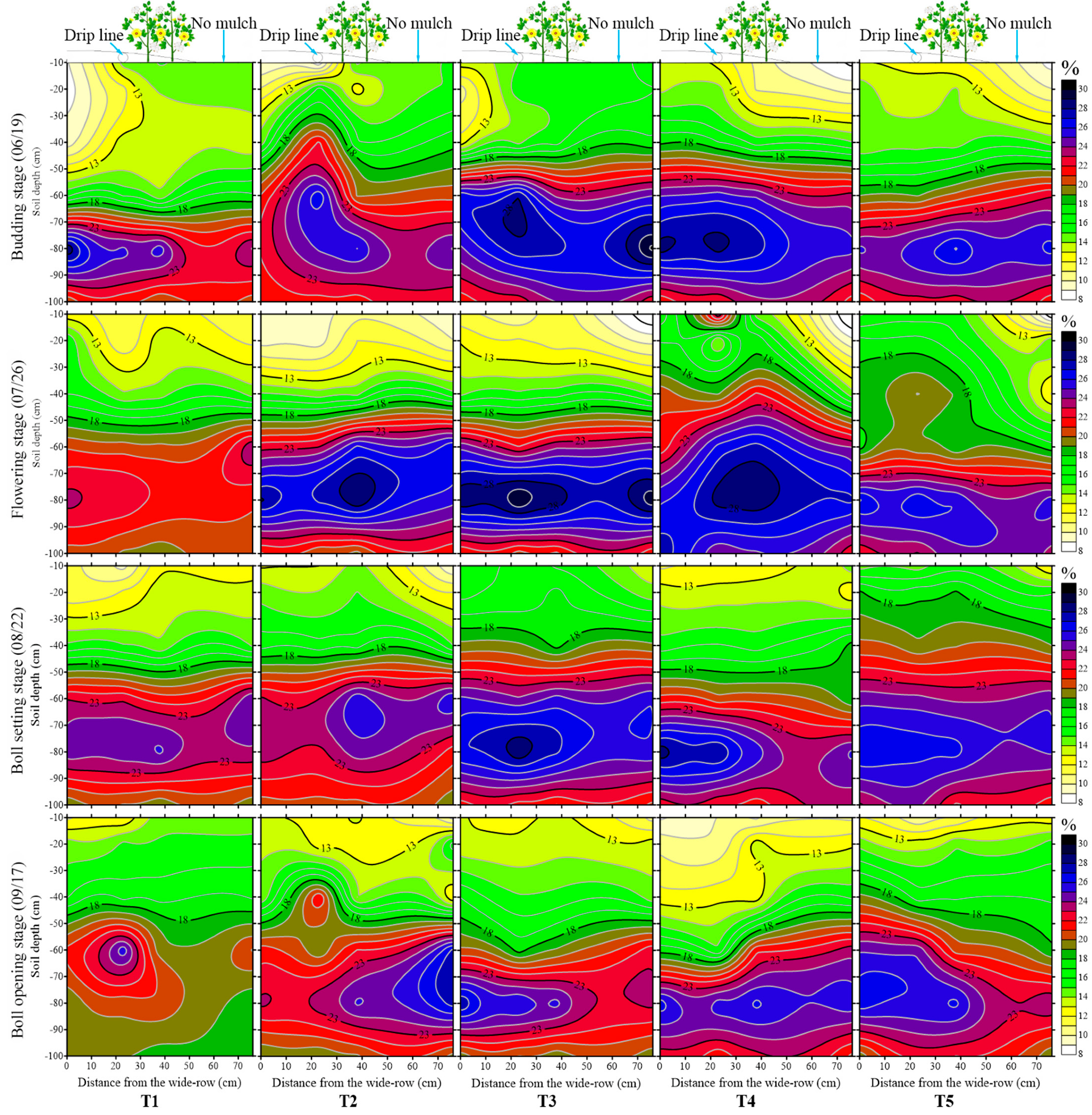

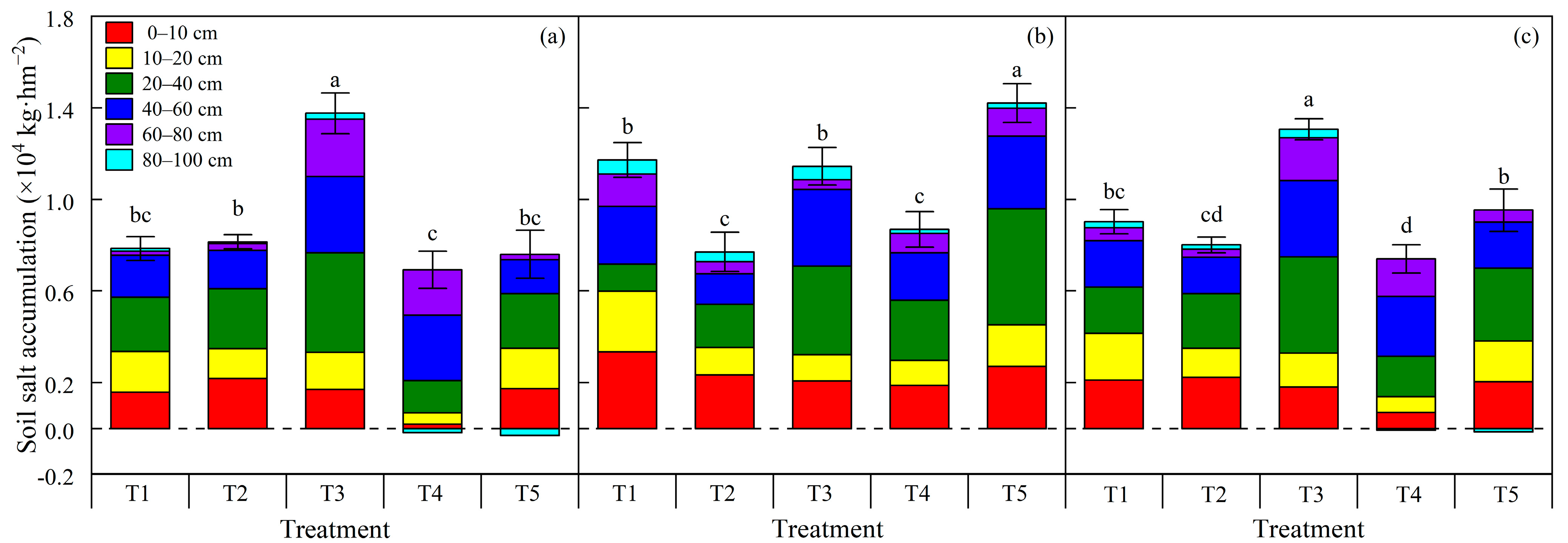
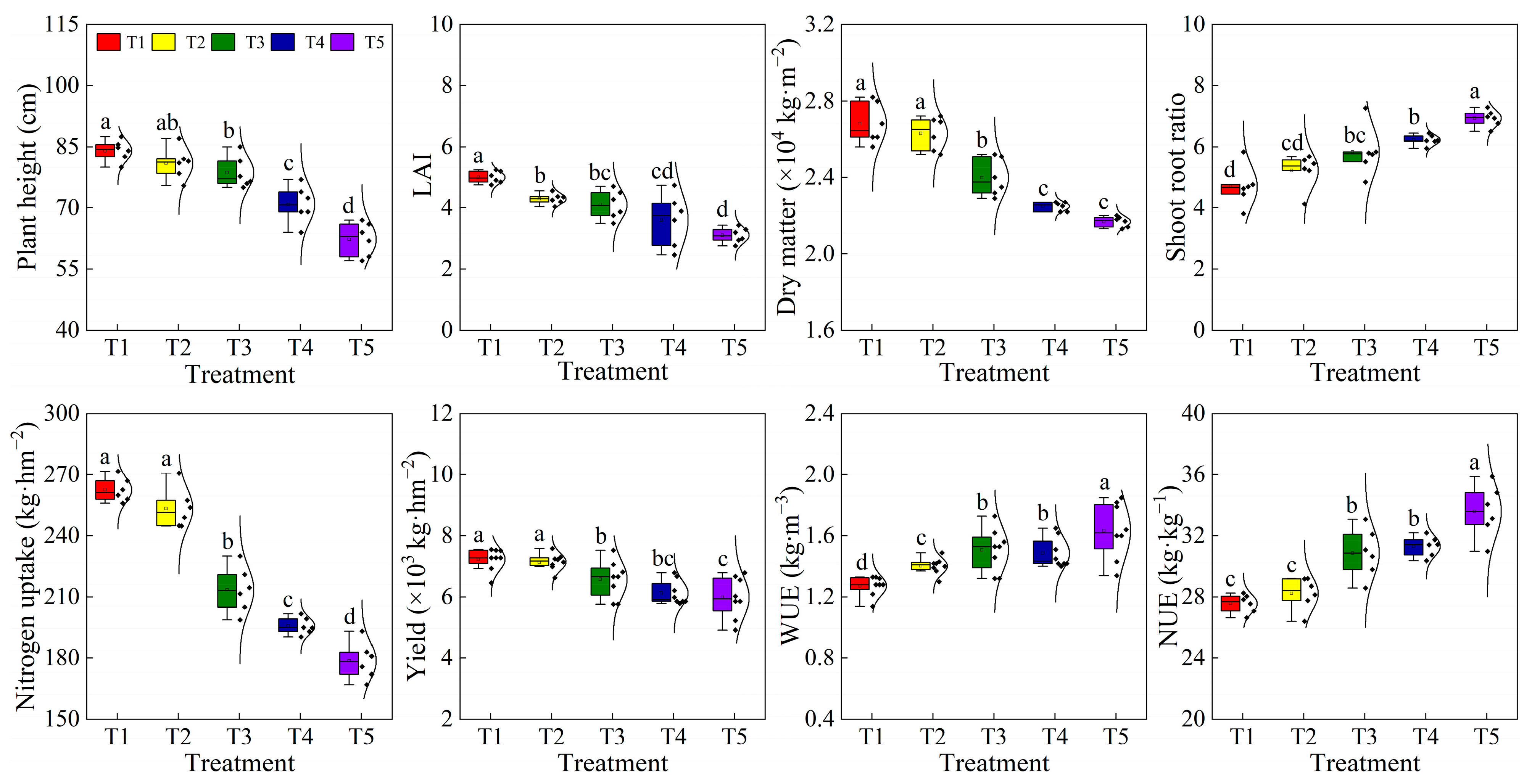
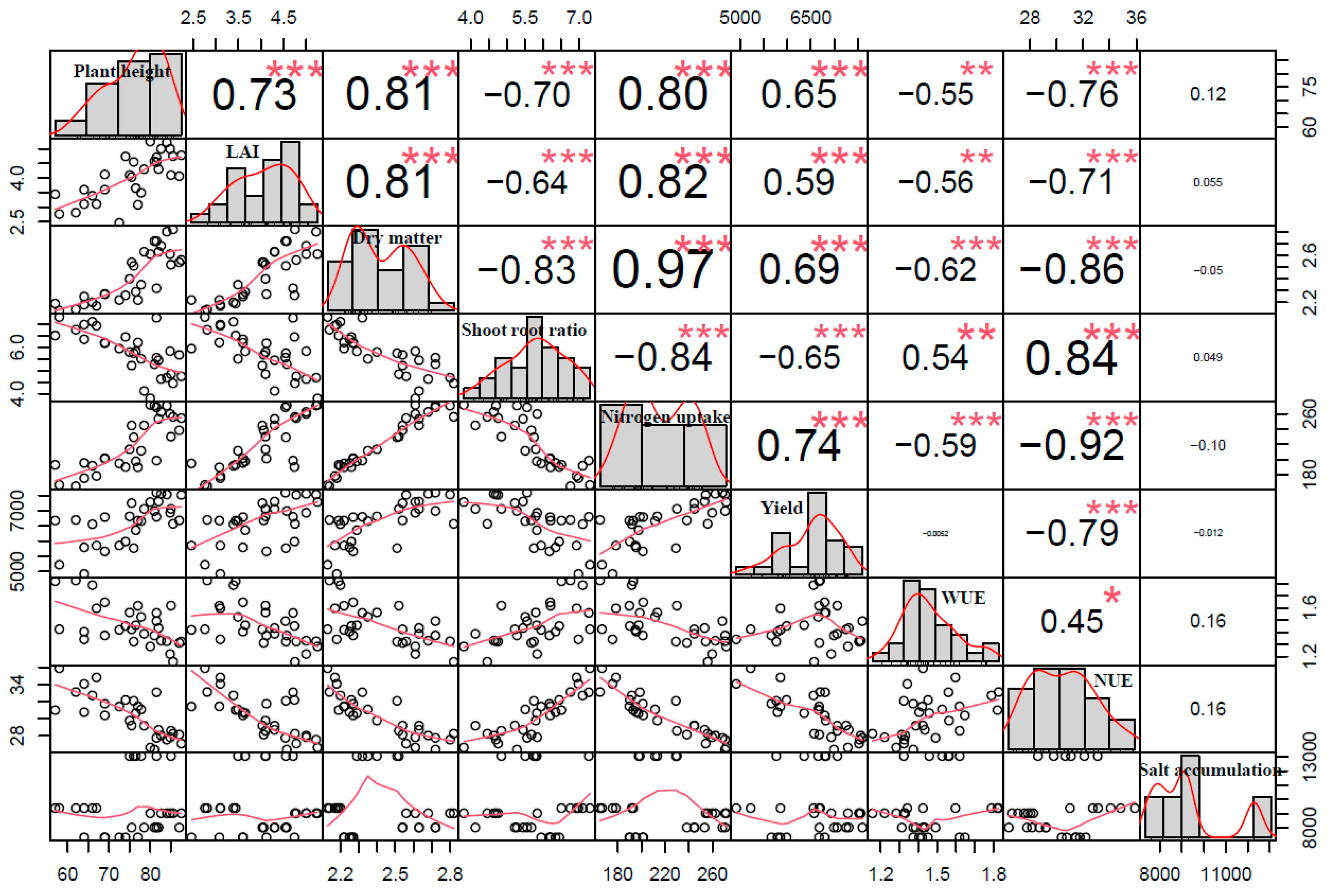
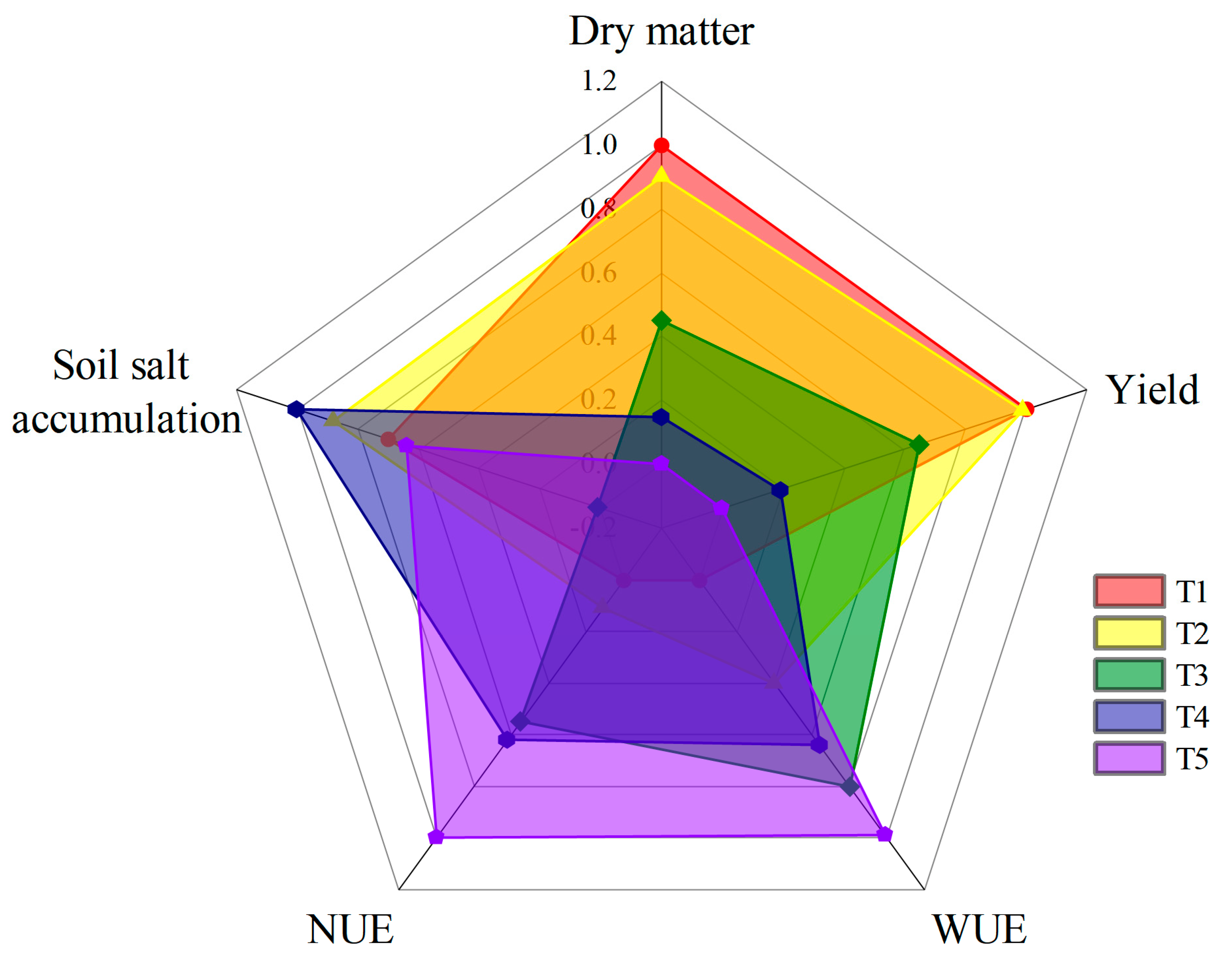



| Depth (cm) | Soil Texture | Soil Mechanical Composition (%) | Bulk Density (g∙cm−3) | FC (cm3·cm−3) | Wilting Point (cm3·cm−3) | Initial Soil Water Content (cm3·cm−3) | Initial Soil Salinity (g∙kg−1) | ||
|---|---|---|---|---|---|---|---|---|---|
| Clay | Silt | Sand | |||||||
| 0–10 | Sandy loam | 2.00 | 43.54 | 54.46 | 1.59 | 32.87% | 18.60% | 24.18% | 0.46 |
| 10–20 | Silt loam | 3.30 | 49.30 | 47.41 | 1.44 | 32.86% | 20.52% | 21.63% | 0.43 |
| 20–40 | Silt loam | 2.83 | 51.13 | 46.05 | 1.63 | 27.35% | 13.79% | 32.45% | 0.46 |
| 40–60 | Sandy loam | 3.12 | 44.79 | 52.09 | 1.57 | 31.23% | 18.60% | 38.78% | 0.53 |
| 60–80 | Sandy | 0.00 | 10.16 | 89.84 | 1.70 | 20.74% | 11.82% | 34.78% | 0.63 |
| 80–100 | Sandy | 0.00 | 6.80 | 93.20 | 1.66 | 20.54% | 11.70% | 32.34% | 0.63 |
| Treatment | Irrigation Quota and Times at Growth Stages | Total Irrigation Amount (mm) | Crop Water Consumption (mm) | ||||
|---|---|---|---|---|---|---|---|
| Seedling Stage | Budding Stage | Flowering Stage | Boll Setting Stage | Boll Bearing Stage | |||
| (11 April~5 June) | (6 June~30 June) | (1 July~25 July) | (26 July~19 August) | (20 August~20 September) | |||
| T1 | 15 × 1 | 13 × 6 | 19 × 6 | 19 × 7 | 19 × 2 | 378 | 568 |
| T2 | 15 × 1 | 21 × 3 | 32 × 3 | 32 × 4 | 32 × 1 | 334 | 509 |
| T3 | 15 × 1 | 29 × 2 | 45 × 2 | 45 × 2 | 0 | 253 | 436 |
| T4 | 15 × 1 | 38 × 1 | 58 × 1 | 58 × 1 | 58 × 1 | 227 | 412 |
| T5 | 15 × 1 | 46 × 1 | 70 × 1 | 70 × 1 | 0 | 201 | 367 |
Disclaimer/Publisher’s Note: The statements, opinions and data contained in all publications are solely those of the individual author(s) and contributor(s) and not of MDPI and/or the editor(s). MDPI and/or the editor(s) disclaim responsibility for any injury to people or property resulting from any ideas, methods, instructions or products referred to in the content. |
© 2023 by the authors. Licensee MDPI, Basel, Switzerland. This article is an open access article distributed under the terms and conditions of the Creative Commons Attribution (CC BY) license (https://creativecommons.org/licenses/by/4.0/).
Share and Cite
He, P.; Li, J.; Yu, S.; Ma, T.; Ding, J.; Zhang, F.; Chen, K.; Guo, S.; Peng, S. Soil Moisture Regulation under Mulched Drip Irrigation Influences the Soil Salt Distribution and Growth of Cotton in Southern Xinjiang, China. Plants 2023, 12, 791. https://doi.org/10.3390/plants12040791
He P, Li J, Yu S, Ma T, Ding J, Zhang F, Chen K, Guo S, Peng S. Soil Moisture Regulation under Mulched Drip Irrigation Influences the Soil Salt Distribution and Growth of Cotton in Southern Xinjiang, China. Plants. 2023; 12(4):791. https://doi.org/10.3390/plants12040791
Chicago/Turabian StyleHe, Pingru, Jingang Li, Shuang’en Yu, Tao Ma, Jihui Ding, Fucang Zhang, Kaiwen Chen, Shuaishuai Guo, and Suhan Peng. 2023. "Soil Moisture Regulation under Mulched Drip Irrigation Influences the Soil Salt Distribution and Growth of Cotton in Southern Xinjiang, China" Plants 12, no. 4: 791. https://doi.org/10.3390/plants12040791
APA StyleHe, P., Li, J., Yu, S., Ma, T., Ding, J., Zhang, F., Chen, K., Guo, S., & Peng, S. (2023). Soil Moisture Regulation under Mulched Drip Irrigation Influences the Soil Salt Distribution and Growth of Cotton in Southern Xinjiang, China. Plants, 12(4), 791. https://doi.org/10.3390/plants12040791










